2015 KIA Sportage center console
[x] Cancel search: center consolePage 21 of 499
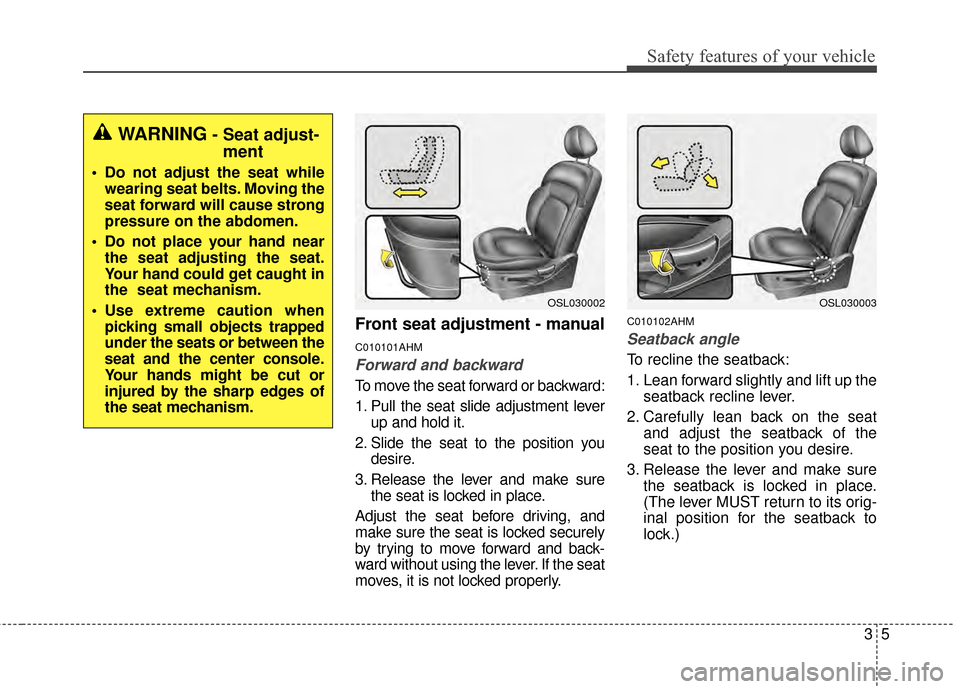
35
Safety features of your vehicle
Front seat adjustment - manual
C010101AHM
Forward and backward
To move the seat forward or backward:
1. Pull the seat slide adjustment leverup and hold it.
2. Slide the seat to the position you desire.
3. Release the lever and make sure the seat is locked in place.
Adjust the seat before driving, and
make sure the seat is locked securely
by trying to move forward and back-
ward without using the lever. If the seat
moves, it is not locked properly.
C010102AHM
Seatback angle
To recline the seatback:
1. Lean forward slightly and lift up the seatback recline lever.
2. Carefully lean back on the seat and adjust the seatback of the
seat to the position you desire.
3. Release the lever and make sure the seatback is locked in place.
(The lever MUST return to its orig-
inal position for the seatback to
lock.)
WARNING- Seat adjust-ment
Do not adjust the seat while
wearing seat belts. Moving the
seat forward will cause strong
pressure on the abdomen.
Do not place your hand near the seat adjusting the seat.
Your hand could get caught in
the seat mechanism.
Use extreme caution when picking small objects trapped
under the seats or between the
seat and the center console.
Your hands might be cut or
injured by the sharp edges of
the seat mechanism.
OSL030002OSL030003
Page 70 of 499
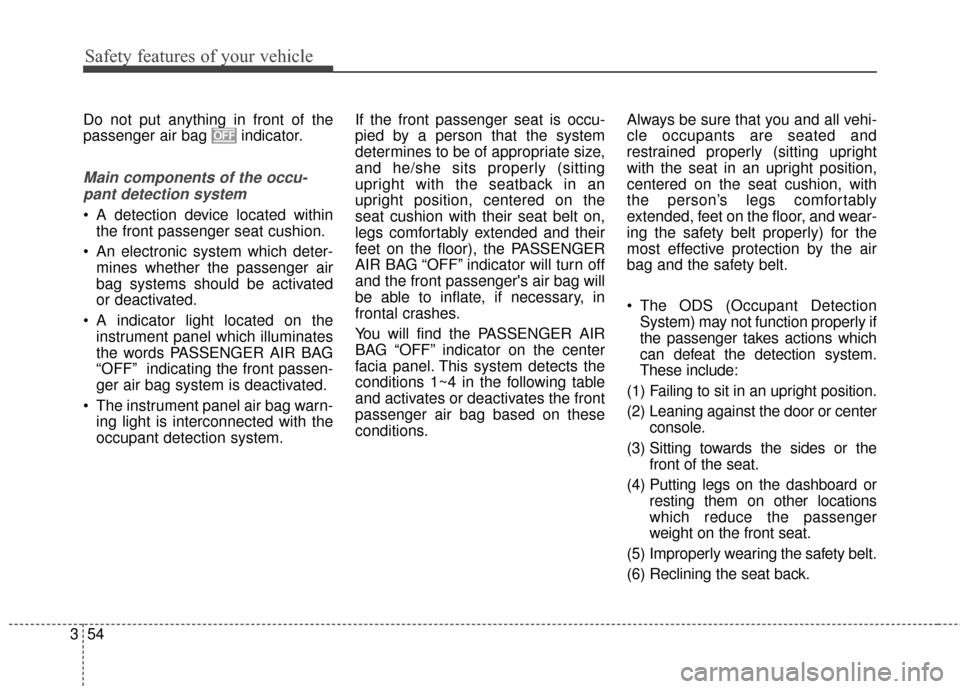
Safety features of your vehicle
54
3
Do not put anything in front of the
passenger air bag indicator.
Main components of the occu-
pant detection system
A detection device located within the front passenger seat cushion.
An electronic system which deter- mines whether the passenger air
bag systems should be activated
or deactivated.
A indicator light located on the instrument panel which illuminates
the words PASSENGER AIR BAG
“OFF” indicating the front passen-
ger air bag system is deactivated.
The instrument panel air bag warn- ing light is interconnected with the
occupant detection system. If the front passenger seat is occu-
pied by a person that the system
determines to be of appropriate size,
and he/she sits properly (sitting
upright with the seatback in an
upright position, centered on the
seat cushion with their seat belt on,
legs comfortably extended and their
feet on the floor), the PASSENGER
AIR BAG “OFF” indicator will turn off
and the front passenger's air bag will
be able to inflate, if necessary, in
frontal crashes.
You will find the PASSENGER AIR
BAG “OFF” indicator on the center
facia panel. This system detects the
conditions 1~4 in the following table
and activates or deactivates the front
passenger air bag based on these
conditions.
Always be sure that you and all vehi-
cle occupants are seated and
restrained properly (sitting upright
with the seat in an upright position,
centered on the seat cushion, with
the person’s legs comfortably
extended, feet on the floor, and wear-
ing the safety belt properly) for the
most effective protection by the air
bag and the safety belt.
The ODS (Occupant Detection
System) may not function properly if
the passenger takes actions which
can defeat the detection system.
These include:
(1) Failing to sit in an upright position.
(2) Leaning against the door or center console.
(3) Sitting towards the sides or the front of the seat.
(4) Putting legs on the dashboard or resting them on other locations
which reduce the passenger
weight on the front seat.
(5) Improperly wearing the safety belt.
(6) Reclining the seat back.
Page 206 of 499
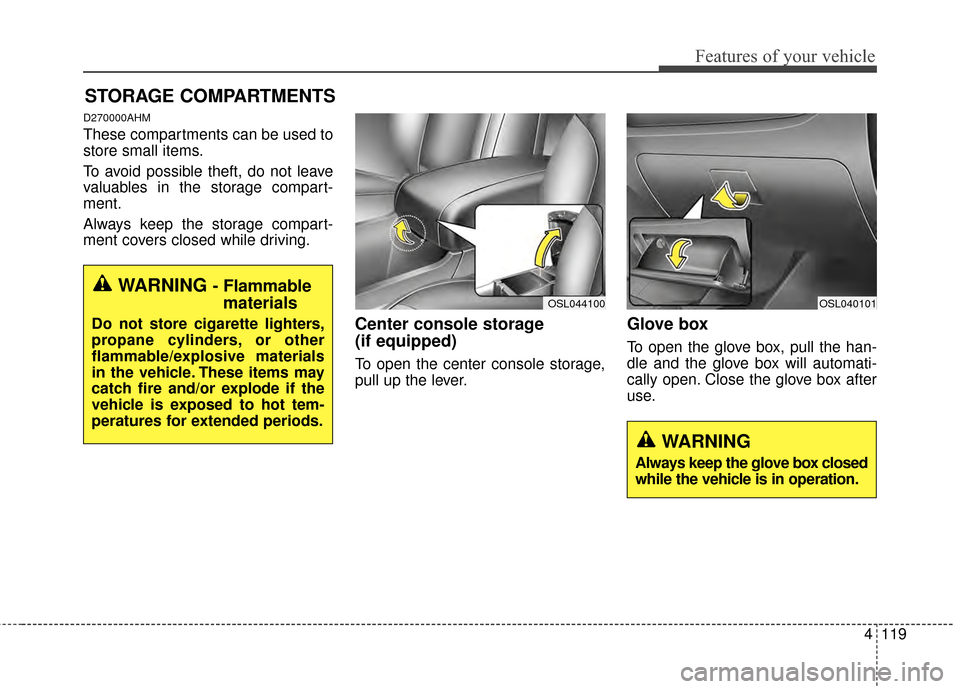
4119
Features of your vehicle
D270000AHM
These compartments can be used to
store small items.
To avoid possible theft, do not leave
valuables in the storage compart-
ment.
Always keep the storage compart-
ment covers closed while driving.
Center console storage
(if equipped)
To open the center console storage,
pull up the lever.
Glove box
To open the glove box, pull the han-
dle and the glove box will automati-
cally open. Close the glove box after
use.
STORAGE COMPARTMENTS
WARNING - Flammablematerials
Do not store cigarette lighters,
propane cylinders, or other
flammable/explosive materials
in the vehicle. These items may
catch fire and/or explode if the
vehicle is exposed to hot tem-
peratures for extended periods.
OSL044100OSL040101
WARNING
Always keep the glove box closed
while the vehicle is in operation.
Page 397 of 499
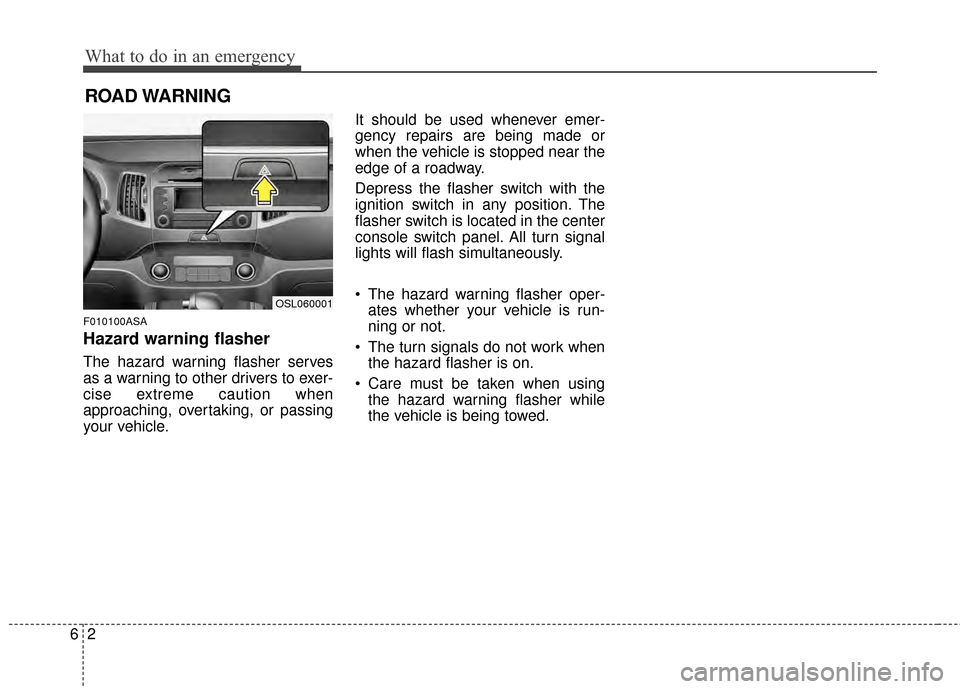
What to do in an emergency
26
ROAD WARNING
F010100ASA
Hazard warning flasher
The hazard warning flasher serves
as a warning to other drivers to exer-
cise extreme caution when
approaching, overtaking, or passing
your vehicle.It should be used whenever emer-
gency repairs are being made or
when the vehicle is stopped near the
edge of a roadway.
Depress the flasher switch with the
ignition switch in any position. The
flasher switch is located in the center
console switch panel. All turn signal
lights will flash simultaneously.
• The hazard warning flasher oper-
ates whether your vehicle is run-
ning or not.
The turn signals do not work when the hazard flasher is on.
Care must be taken when using the hazard warning flasher while
the vehicle is being towed.
OSL060001
Page 498 of 499
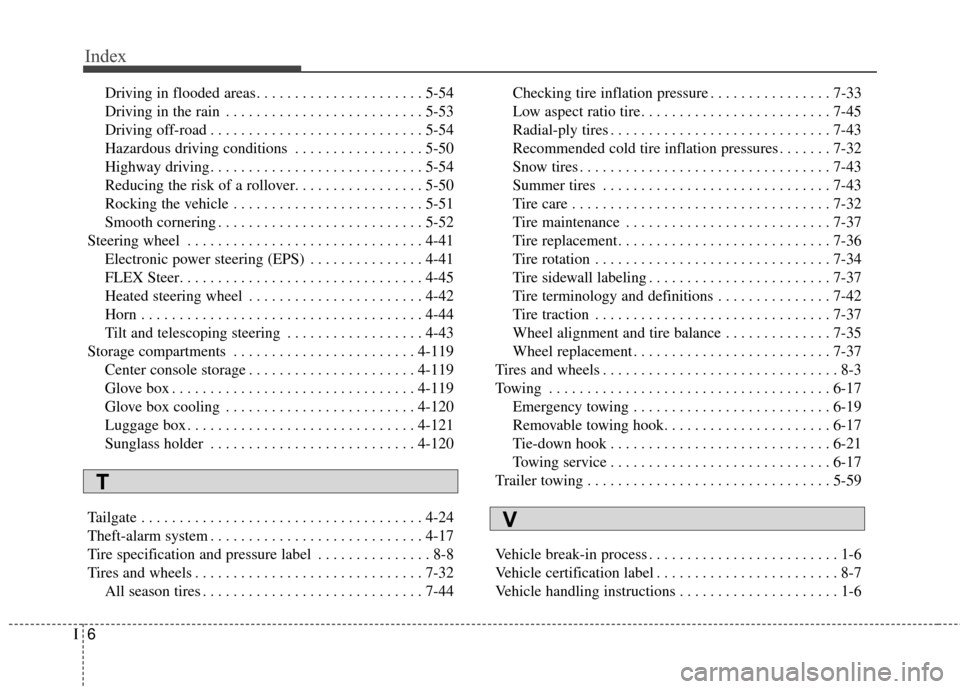
Index
6I
Driving in flooded areas. . . . . . . . . . . . . . . . . . . . . . 5-54
Driving in the rain . . . . . . . . . . . . . . . . . . . . . . . . . . 5-53
Driving off-road . . . . . . . . . . . . . . . . . . . . . . . . . . . . 5-54
Hazardous driving conditions . . . . . . . . . . . . . . . . . 5-50
Highway driving. . . . . . . . . . . . . . . . . . . . . . . . . . . . 5-54
Reducing the risk of a rollover. . . . . . . . . . . . . . . . . 5-50
Rocking the vehicle . . . . . . . . . . . . . . . . . . . . . . . . . 5-51
Smooth cornering . . . . . . . . . . . . . . . . . . . . . . . . . . . 5-52
Steering wheel . . . . . . . . . . . . . . . . . . . . . . . . . . . . . . . 4-41 Electronic power steering (EPS) . . . . . . . . . . . . . . . 4-41
FLEX Steer. . . . . . . . . . . . . . . . . . . . . . . . . . . . . . . . 4-45
Heated steering wheel . . . . . . . . . . . . . . . . . . . . . . . 4-42
Horn . . . . . . . . . . . . . . . . . . . . . . . . . . . . . . . . . . . . \
. 4-44
Tilt and telescoping steering . . . . . . . . . . . . . . . . . . 4-43
Storage compartments . . . . . . . . . . . . . . . . . . . . . . . . 4-119 Center console storage . . . . . . . . . . . . . . . . . . . . . . 4-119
Glove box . . . . . . . . . . . . . . . . . . . . . . . . . . . . . . . . 4-119
Glove box cooling . . . . . . . . . . . . . . . . . . . . . . . . . 4-120
Luggage box . . . . . . . . . . . . . . . . . . . . . . . . . . . . . . 4-121
Sunglass holder . . . . . . . . . . . . . . . . . . . . . . . . . . . 4-120
Tailgate . . . . . . . . . . . . . . . . . . . . . . . . . . . . . . . . . . . . \
. 4-24
Theft-alarm system . . . . . . . . . . . . . . . . . . . . . . . . . . . . 4-17
Tire specification and pressure label . . . . . . . . . . . . . . . 8-8
Tires and wheels . . . . . . . . . . . . . . . . . . . . . . . . . . . . . . 7-32 All season tires . . . . . . . . . . . . . . . . . . . . . . . . . . . . . 7-44 Checking tire inflation pressure . . . . . . . . . . . . . . . . 7-33
Low aspect ratio tire. . . . . . . . . . . . . . . . . . . . . . . . . 7-45
Radial-ply tires . . . . . . . . . . . . . . . . . . . . . . . . . . . . . 7-43
Recommended cold tire inflation pressures . . . . . . . 7-32
Snow tires . . . . . . . . . . . . . . . . . . . . . . . . . . . . . . . . . 7-43
Summer tires . . . . . . . . . . . . . . . . . . . . . . . . . . . . . . 7-43
Tire care . . . . . . . . . . . . . . . . . . . . . . . . . . . . . . . . . . 7-32\
Tire maintenance . . . . . . . . . . . . . . . . . . . . . . . . . . . 7-37
Tire replacement . . . . . . . . . . . . . . . . . . . . . . . . . . . . 7-36
Tire rotation . . . . . . . . . . . . . . . . . . . . . . . . . . . . . . . 7-34
Tire sidewall labeling . . . . . . . . . . . . . . . . . . . . . . . . 7-37
Tire terminology and definitions . . . . . . . . . . . . . . . 7-42
Tire traction . . . . . . . . . . . . . . . . . . . . . . . . . . . . . . . 7-37
Wheel alignment and tire balance . . . . . . . . . . . . . . 7-35
Wheel replacement . . . . . . . . . . . . . . . . . . . . . . . . . . 7-37
Tires and wheels . . . . . . . . . . . . . . . . . . . . . . . . . . . . . . . 8-3
Towing . . . . . . . . . . . . . . . . . . . . . . . . . . . . . . . . . . . . \
. 6-17 Emergency towing . . . . . . . . . . . . . . . . . . . . . . . . . . 6-19
Removable towing hook. . . . . . . . . . . . . . . . . . . . . . 6-17
Tie-down hook . . . . . . . . . . . . . . . . . . . . . . . . . . . . . 6-21
Towing service . . . . . . . . . . . . . . . . . . . . . . . . . . . . . 6-17
Trailer towing . . . . . . . . . . . . . . . . . . . . . . . . . . . . . . . . 5-59
Vehicle break-in process . . . . . . . . . . . . . . . . . . . . . . . . . 1-6
Vehicle certification label . . . . . . . . . . . . . . . . . . . . . . . . 8-7
Vehicle handling instructions . . . . . . . . . . . . . . . . . . . . . 1-6
T
V